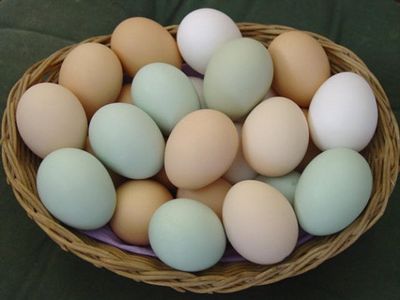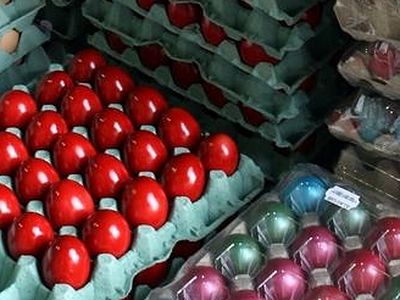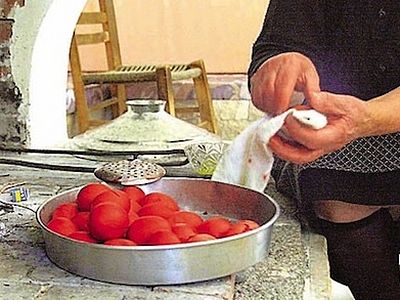SOURCE: Denver Post
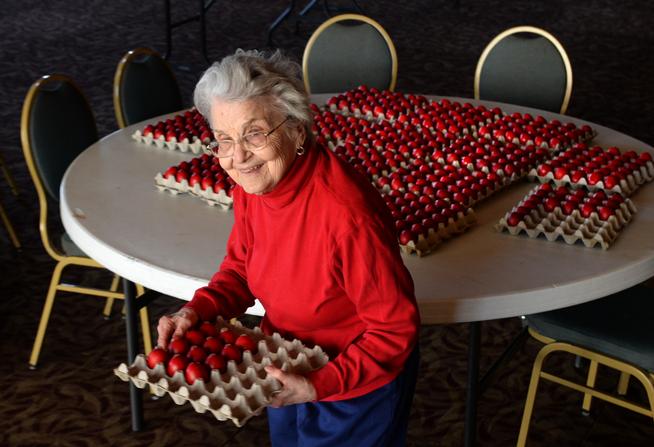 Theano Peros, 89, picked out a dozen eggs to take home after she and the Women of the Greek Orthodox Cathedral dyed more than 1,200 of them to be sold or handed out to worshipers on Easter Sunday. (Karl Gehring, The Denver Post)
Theano Peros, 89, picked out a dozen eggs to take home after she and the Women of the Greek Orthodox Cathedral dyed more than 1,200 of them to be sold or handed out to worshipers on Easter Sunday. (Karl Gehring, The Denver Post)
Earlier this month, at the Greek Orthodox Cathedral in Denver, a team of women boiled 1,200 eggs and colored them red with dye imported from Greece.
"It's just like we did it there," said Dena Kitsos, who grew up in Pikarni, a small village outside Athens, and emigrated to Denver in 1954.
She remembers the candlelit Easter vigils of her childhood, when red eggs symbolizing the blood of Christ were given to everyone at church, followed by a meal of lamb soup and tsoureki, the Greek Easter bread decorated with red eggs.
This is one of those rare years when both the Eastern Orthodox and Western Christian churches celebrate Easter on the same day. So eggs will be everywhere Sunday, and Colorado's hens — more than 3.87 million of them — have been busy.
The egg has long symbolized new life, even before Christianity. Pagan spring festivals were celebrated with eggs, and the word Easter even has pagan connections. It comes from the Old English word Eastre, or Eostre. Eostre was the name of an Anglo-Saxon goddess of the dawn.In Parker, Thrive Church is hosting an Easter egg hunt with 10,000 eggs, and the Easter egg hunt at Copper Mountain features 50,000 eggs.
"The egg is about rebirth, and it's also about giving vitality every spring to newness of young animals and young children," said Wira Babiak of Erie, an artist of Ukrainian heritage who specializes in the elaborate Ukrainian Easter eggs known as pysanky.
In different countries and cultures, the egg has become a magnet for different meanings. Earlier this month, the Ukrainian Easter egg even took on political nuance.
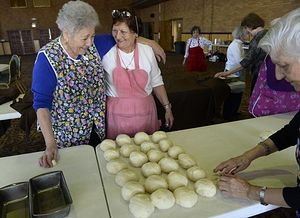 From left, Dena Kitsos, Katina Kapantas and Rose Evridis — members of Philoptochos, meaning friends of the poor — prepare 150 loaves of Easter bread at Assumption of the Theotokos Greek Orthodox Metropolis Cathedral. (Kathryn Scott Osler, The Denver Post)
From left, Dena Kitsos, Katina Kapantas and Rose Evridis — members of Philoptochos, meaning friends of the poor — prepare 150 loaves of Easter bread at Assumption of the Theotokos Greek Orthodox Metropolis Cathedral. (Kathryn Scott Osler, The Denver Post)
"It's a prayer because the Easter egg itself is a religious artifact on its own," said Babiak. "It's also about strength, sharing, and putting that inner vibrancy and positivism out there."
Pysanky is particularly popular with crafters and artists, with lots of postings on Pinterest. Meghan McGinnes, who grew up in the Russian Orthodox tradition, teaches pysankyworkshops at the Hiwan Homestead Museum in Evergreen.
When she started pysanky as a teenager, she said, "it was more of an art thing, but when I became a grown-up, it meant more to me as a tradition. When I got into teaching it, I wanted to teach the symbolism. It's not just a pretty design — everything you put on the egg has some kind of symbolism, including what color you use."
Ludmila Kamaeff, who works at Russian Books and Movies in Denver, grew up in Moldova but left for America in 1992 after civil war divided the country. When she thinks back on Easter in Russia, she remembers using onion skins to dye eggs for Easter.
"Everyone makes a special Easter cake called paskha that you eat with the eggs when you get back from church," she said.
The cake's top is round, as are Russia's onion-domed churches.
But for Kamaeff, what the cake really evokes is interfaith friendship. In Moldova, she shared her Jewish neighbor's matzo bread for Passover, and then her neighbor made her paskhacake for Easter.
"It brought us together," she said.
Alexxa Gagner, spokeswoman for the Denver Rescue Mission, grew up in Phoenix with the same Greek Orthodox traditions practiced earlier this month in Denver.
"Some of my earliest memories are going to my church and dyeing the eggs with a lot of the older ladies," she said. "I'll always remember, as a kid, being really excited about getting that egg."
Colleen O'Connor: 303-954-1083, coconnor@denverpost.com or twitter.com/coconnordp
